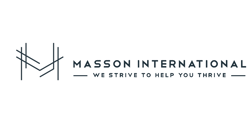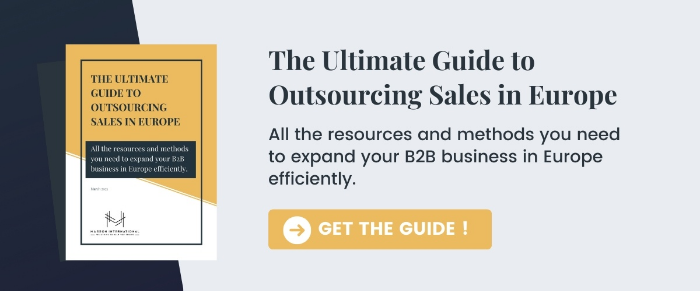Summary
1. The Main Pricing Models Used by Lead Gen Companies
2. Typical Costs for Outsourced Lead Generation in Europe
3. What Drives the Cost Up or Down?
4. How GDPR, Language & Culture Impact Lead Gen in Europe
5. How to Evaluate ROI and Avoid Wasting Money
Should You Outsource Your Lead Generation?
Outsourced Lead Generation in Europe: FAQs
Thinking about outsourcing your lead generation — but not sure what it should cost, or if it’s even worth it?
You’re not alone. Many B2B companies want to grow faster and more efficiently, but understanding the real cost of outsourced lead generation is tricky.
In this guide, we break down the different pricing models, what impacts costs, and how to make sure you’re getting real ROI — not just empty leads.
What Does “Outsourced Lead Generation” Really Mean?
It means handing over the work of finding and qualifying prospects to an external team, so you can focus on selling. Depending on the partner, this could include outbound calling, LinkedIn outreach, email nurturing, or a full-funnel strategy.
The Main Pricing Models Used by Lead Gen Companies
Outsourcing lead generation involves several pricing structures companies can choose based on their needs and budget. The average cost per lead by industry varies significantly.
Typical Pricing Structures in Europe
These pricing models support diverse business strategies, especially for companies seeking outbound lead generation in Europe to reach new customers effectively:
- Per-Lead Pricing: In this model, companies pay only for each qualified lead provided, often without a minimum requirement. Businesses are charged when potential customers take specific actions, like submitting contact information or filling out a form. This approach ensures payment is tied to real, interested leads, motivating agencies to prioritize quality. However, it can be resource-intensive. This is because generating qualified leads requires significant effort from both the business and the lead generation company.
Want to know if outsourced lead gen in Europe is right for your business?
Talk to our team and we’ll walk you through what it could look like — and how much it might cost you.
👉 Book a free call
- Retainer-Based Pricing: In this scenario, companies pay a fixed monthly or quarterly fee, allowing for a consistent flow of high-quality leads. This model benefits companies with ongoing needs for strategic outreach. This may be especially beneficial in multi-market expansions within Europe, as it enables flexibility to adjust based on monthly performance.
- Hourly Rates: Although less common, some agencies offer an hourly pricing model. This may be beneficial for specific projects like market research or limited-term campaigns. However, hourly rates may lead to unpredictable expenses. This would particularly be the case if the project scope grows over time.
Why Pricing Varies Across Providers and Countries
Pricing structures for outsourced lead generation vary widely across European countries.
Western Europe generally has higher labor and regulatory costs. This leads to higher fees, whereas Eastern Europe may offer more competitive rates.
Established agencies with solid reputations and advanced technology may also command higher fees. Examples would be industries like finance or technology.
Lead generation costs fluctuate significantly by industry. For instance, financial services see high costs due to compliance and specialized outreach needs. On the other hand, sectors like eCommerce incur lower costs due to simpler targeting requirements.
Typical Costs for Outsourced Lead Generation in Europe
To better understand outsourced lead generation in Europe, it's helpful to look at general cost ranges based on the size and type of agency a company might engage with, as well as whether they charge a cost per month or per performance.
Overview of Typical Cost Ranges for Lead Generation in Europe
Here’s a hypothetical breakdown based on agency size and service level. While actual costs vary, these ranges provide a general idea of what companies might expect:
- Small Agencies: These boutique providers often charge on the lower end. Costs range from $10 to $50 per lead. Small agencies work well for businesses needing a manageable volume of leads, typically without extensive customization. This range suits companies in sectors like eCommerce or retail, where generalized lead generation strategies can yield effective results.
Selling SaaS? Find out how to grow your SaaS business in Europe!
- Medium to Large Agencies: More established agencies, providing data-driven lead generation services, generally charge around $50 to $200 per lead. These agencies offer strategic support such as CRM integrations, performance tracking, and segmentation. This makes them ideal for companies planning to expand across multiple European regions. Businesses in fields like technology or business services often work with agencies in this range to benefit from a balance of volume and quality in lead generation.
- High-End Specialized Agencies: Agencies specializing in highly targeted or industry-specific lead generation, especially in regulated sectors, may charge on the higher end, from $200 up to $500 per lead. These agencies cater to enterprise-level clients who require deep customization, industry compliance, or multi-market campaigns across Europe. For example, companies in financial services or healthcare might engage with high-end agencies to meet stringent compliance requirements and access premium lead qualification standards.
| Provider Type | Cost per Lead | Best for |
|---|---|---|
| Small Agencies | $10–$50 | Basic volume needs |
| Mid-Sized Specialists | $50–$200 | Multi-market B2B growth |
| High-End Experts | $200–$500 | Niche or regulated sectors |
What Drives the Cost Up or Down?
The cost of outsourced lead generation and sales outsourcing services in Europe depends on several critical factors. Understanding these can help businesses tailor their budget and expectations.
Key Criteria That Impact Rates
- Level of Customization and Complexity: Industries with specific compliance needs, like healthcare or finance, often demand unique campaigns, which increases costs. B2B (business-to-business) companies in sectors such as healthcare and technology typically experience higher lead generation costs than B2C (business-to-consumer) companies in retail or non-profit sectors. This is due to longer sales cycles and more complex decision-making processes involved in B2B transactions. The more tailored a campaign is to a target audience, the more resources are required to ensure quality engagement.
- Volume of Leads Required Monthly: The quantity of leads needed influences costs. Generating larger volumes typically requires more personnel, tools, and data management resources. Agencies may provide discounts for higher lead volumes, but these packages are generally more expensive. Target market specifics, such as the demographics and behaviors of your intended audience, also play a role. Campaigns targeting niche audiences with specific needs often require additional resources and strategies. This can potentially raise costs.
- Technology and Tool Costs (CRM Integration, Data Analysis): Lead generation technology and tools, such as AI-driven CRM systems, add to overall costs. For instance, agencies that use tools like HubSpot or Marketo may charge higher fees. These tools enhance lead quality and targeting accuracy by automating lead scoring and nurturing. So, this justifies the investment for businesses who are seeking a higher ROI. The chosen lead generation channels also impact costs; paid channels like PPC and social media ads typically incur higher upfront costs, while organic strategies like SEO and content marketing require a longer-term investment.
- Geographic Targeting within Europe (e.g., Western vs. Eastern Europe): Costs vary based on geographic targeting. Campaigns aimed at Western Europe, where labor and compliance costs are higher, tend to be more expensive. Meanwhile, Eastern European campaigns offer cost advantages without sacrificing lead quality. Additional costs may also arise from localization and multilingual needs. This is especially true for campaigns targeting multiple European markets.
- Contract Length and Scope of Services (One-Time Projects vs. Ongoing Retainers): Agencies may offer discounts for longer-term contracts. One-time projects often have higher per-lead rates, while retainers or multi-month contracts allow for more consistent cost management and lead flow. Lead generation pricing models—such as retainers, performance-based pricing, or project-based fees—also influence costs. Retainer models offer predictable monthly expenses. On the other hand, performance-based options like pay-per-lead ensure payment only for qualified leads but may require a higher commitment for quality assurance.

How GDPR, Language & Culture Impact Lead Gen in Europe
Expanding within Europe involves unique challenges. Businesses should consider several regional factors that affect lead generation costs and strategies, all of which play a critical role in a successful European sales strategy.
- Compliance Requirements (GDPR Considerations): European data protection regulations, particularly GDPR, impact how agencies handle customer data for lead generation. GDPR compliance adds operational costs for secure data handling, obtaining consent, and regular audits. This is essential to avoid legal risks.
- Multilingual Lead Generation and Additional Costs for Localization: Companies targeting multiple European countries often need multilingual campaigns. This adds to lead generation costs because agencies need skilled personnel fluent in local languages to handle culturally tailored outreach.
- Cultural Nuances in Sales Outreach and Local Expertise: Understanding local business etiquette, preferences, and market dynamics is crucial. This is especially true in diverse markets like France, Germany, and Spain. Agencies that employ local experts or have on-the-ground presence charge more for this cultural insight, which often enhances engagement quality.
A company entering France, for example, may find that employing French-speaking lead generation teams with a cultural understanding of the market will yield higher conversion rates despite the added cost.
To find out more :
How to build an effective outsourced sales team in Europe?
How to Evaluate ROI and Avoid Wasting Money
Evaluating ROI is essential for measuring the effectiveness of outsourced lead generation and ensuring that it aligns with business goals.
Key Performance Indicators (KPIs) to Consider
- Cost Per Lead (CPL): This KPI shows the average cost of generating a single lead and helps businesses evaluate budget efficiency in lead volume and quality.
- Conversion Rate: Conversion rates indicate the quality of generated leads. High conversion rates suggest well-targeted, qualified leads. This contributes to a stronger ROI.
- Customer Lifetime Value (CLV): Customer Lifetime Value (CLV) is the total revenue a company can expect to earn from a customer throughout their relationship. High CLV justifies a higher investment in lead generation since each customer brings long-term value.
- Sales Pipeline Growth: Pipeline growth reflects lead generation's impact on sales momentum. A steady increase in qualified leads directly supports revenue goals. This makes outsourcing valuable when it shows consistent pipeline contributions.
- Sales Cycle Length: Outsourced lead generation can shorten the sales cycle by delivering better-qualified leads. If lead generation efforts reduce the time it takes to convert prospects into customers, it demonstrates cost-effective efficiency.

Determining the ROI Threshold for Outsourced Efforts
An ROI threshold helps companies assess if their outsourced lead generation investment is worthwhile by setting a minimum acceptable return.
For instance, businesses with high customer retention may accept a higher Cost Per Lead (CPL) if the lifetime value of each customer meets or exceeds this threshold.
Establishing an ROI benchmark guides investment decisions and aligns lead generation spending with revenue expectations.
Importance of Ongoing Monitoring and Flexibility in Contracts
Once the ROI threshold is set, continuous KPI monitoring ensures lead generation efforts stay effective.
Flexible contracts that allow for adjustments based on performance metrics, like CPL and conversion rates, enable companies to refine their approach if results dip below the threshold.
This adaptability keeps outsourced campaigns aligned with evolving business goals.
Should You Outsource Your Lead Generation?
Outsourced lead generation offers a strategic approach for companies looking to expand efficiently while accessing specialized expertise.
Businesses can maximize the value of their lead generation investment by carefully evaluating costs, setting an ROI threshold, and choosing a flexible, performance-aligned contract.
You don’t just need leads — you need qualified leads that close.
Let’s build a lead generation strategy that delivers real ROI.
👉 Get your custom plan
Outsourced Lead Generation in Europe: FAQs
Is outsourced lead generation worth it?
Yes — if your partner delivers high-quality, targeted leads and you have a strong follow-up process in place.
How much does outsourced lead generation typically cost?
In Europe, costs range from $10 to $500 per lead depending on industry, targeting, and provider quality (yes, that's a very wide range. To get a clearer picture, book a call with me!).
Should I pay per lead or go for a retainer?
Retainers offer consistency and strategic support, while pay-per-lead works best if your goals are short-term and well-defined.





